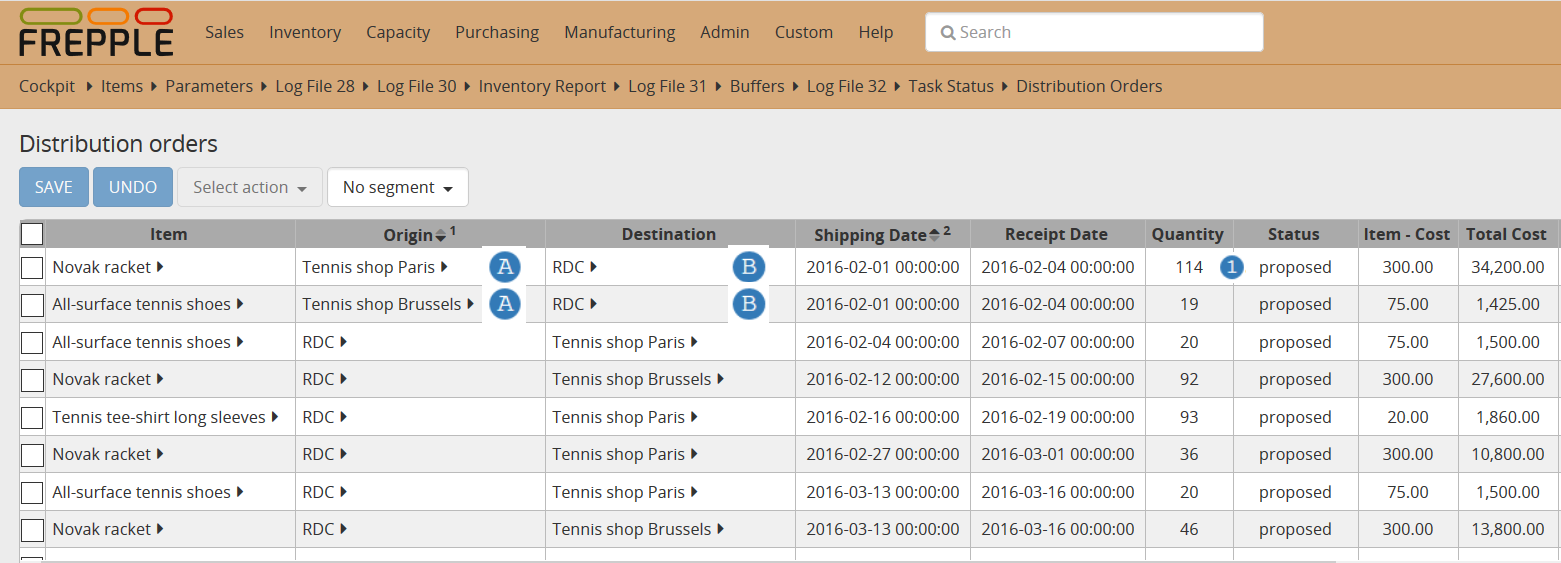Inventory rebalancing
This functionality allows rebalancing excess inventory across locations in the network. The planning algorithm identifies item-locations with excess inventory and proposes shipments that return the excess back to the source location from where it can be sent to other locations.
Rebalancing requests are a special type of distribution orders.
If there exists an item distribution for a given record from an origin location O to a destination location D then frePPLe will generate distribution orders for that item from O to D.
Rebalancing requests are designed to send back some material from the destination location D to the origin location O based on some criteria.
There are three parameters driving the stock rebalancing requests generation :
- REBALANCING_PART_COST_THRESHOLD:The minimum part cost threshold used to trigger a rebalancing. Parts with a cost below the threshold will not be rebalanced.
- REBALANCING_TOTAL_COST_THRESHOLD:The minimum total cost threshold to trigger a rebalancing (equals to rebalanced quantity multiplied by item cost). Rebalancing requests with total cost below the threshold will not be created.
- REBALANCING_BURNOUT_THRESHOLD:If the excess inventory will be consumed and disappear within the “burn out” time window, no rebalancing request will be created.
Check this feature on a live example
Download an Excel spreadsheet with the data for this example
The above instance contains the results of the plan in the Distribution Orders tab.
In this example, we have defined :

- REBALANCING_PART_COST_THRESHOLD = 20.No part with a cost less than 20 is eligible for a rebalancing request.
- REBALANCING_TOTAL_COST_THRESHOLD = 100.No rebalancing request with a total cost (item cost multiplied by request quantity) less than 100 will be created.
- REBALANCING_BURNOUT_THRESHOLD = 90.The rebalancing request quantity should not be less than 90 days of forecasted consumption.
Having a look at the distribution orders screen, you will notice that the first two records
are actually rebalancing requests as the source location is a shop A and the destination location is the regional distribution center (RDC) B.

The two rebalancing requests proposed by the tool are for parts having unit cost of 75 and 300, therefore more than parameter REBALANCING_PART_COST_THRESHOLD value (All-surface tennis shoes, Novak racket).
The two rebalancing requests proposed by the tool are for a total cost of 1425 and 34200, therefore more than parameter REBALANCING_TOTAL_COST_THRESHOLD value.
Important: The quantity of a rebalancing request is equal to (onhand - safety stock - reorder quantity) but a rebalancing request will only be generated if onhand >= safety stock + reorder quantity + burnout quantity.
For the generated rebalancing requests, here is quick summary of the inventory planning solver :
buffer=All-surface tennis shoes @ Tennis shop Paris roq=20.0 ss=5.0 demand=9.0 onhand=3.0
buffer=Novak racket @ Tennis shop Paris roq=35.0 ss=1.0 demand=109.0 onhand=150.0
Let’s take the Novak racket for instance, the monthly forecast for the next 90 days is 35+36+38=109 which is equal to the burnout quantity.
The rebalancing request will only be triggered if onhand >= safety stock + reorder quantity + burnout quantity = 1 + 35 + 109 = 145.
As onhand is 150, then a rebalancing request is generated for a quantity equals to onhand - safety stock - reorder quantity = 150 - 1 - 35 = 114 1.
